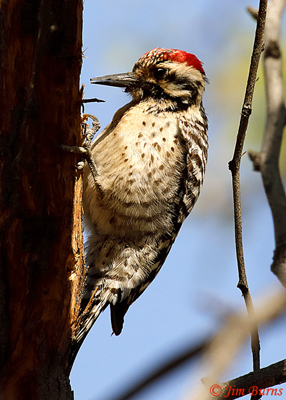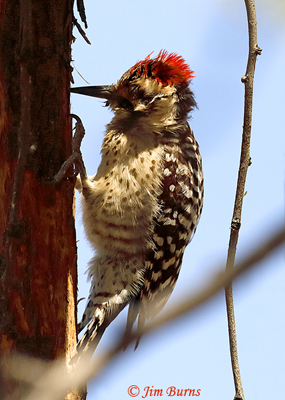|
|
I was puzzled momentarily until I heard the woodpecker’s “queek” call which is invariably reminiscent, to my ear at least, of one of the alarm calls of American Robin with which I grew up in the Midwest. Ladder-backed Woodpecker. My eyes followed my ears to a small, dead mesquite where a male Ladder-back was busy exploring the interstices of the tree’s dried, flaking bark with beak and tongue.
The two photos opening this column were taken, according to the metadata in the camera, twelve seconds apart, and between the first image and the second the bird had “shinnied” three or four inches down the trunk of the tree. In those intervening seconds between the photos two things had obviously changed. I had changed my position slightly, trying to avoid intervening shadows and branches, but something quite odd had changed in the woodpecker’s appearance, right? Look at the red crown patch.
“What just happened” I asked myself as I peered at the enlargements side-by-side on the back of the camera, but the bird’s changed appearance in the second image was so bizarre I must admit I muttered WTF. When I looked at the bird again through the binoculars, except for his slight change in position on the tree, he looked exactly as he had in the first image. Here’s what I think happened.
Remember the last time someone walked up behind you unheard and unexpected as you concentrated on some task at hand, reading, looking at your phone, whatever, and that person mischievously or inadvertently startled the bejesus out of you. You had an adrenaline rush, however brief the encounter might have been, but if you had been reading Stephen King on a stormy night and something tapped against the window, you’d have felt chills running down your spine and the hairs on your arm would have stood up.
The latter is caused by goose bumps, and it’s called piloerection. Muscles at the base of the hair follicles contract causing depressions in the skin surface which, in turn, cause the hair to protrude. You’ve seen this, in cartoons if not in person, when porcupines erect their quills as a defense mechanism to make themselves appear bigger. You’ve seen birds do it too, plumping themselves out and raising their crests when they sense danger.
Just as I snapped the first of these two frames I remember seeing, peripherally, a large shadow pass overhead. My guess is that a raptor, perhaps a Cooper’s Hawk, flew over and the Ladder-back saw it too, or perhaps just sensed it, and reacted momentarily until the danger passed. In addition to the red “mohawk” he does looked plumped out in both frames.
In the avian world survival depends on this evolutionarily granular awareness of surroundings. This fight or flight adaptation still resides deep in the recesses of our own species’ DNA, but be thankful most of us don’t need it anymore on a daily basis.
